For many saltwater fish enthusiasts, Clownfish are by far one of the most popular fish species, and for good reason.
Not only have Clownfish risen in popularity due to their roles in the popular film series "Finding Nemo", but they are hardy little marine fish that requires surprisingly little maintenance, making them perfect for beginners. Their exotic patterns and coloration also add to the allure of Clownfish, and what most people don't know is that there are actually many different types of Clownfish, not just the generic "Nemo" clown.
Funnily enough, even with generic-looking Clownfish, there are differences in species. Take the Percula Clownfish vs Ocellaris Clownfish debate for example. They both look almost identical, but are different types of clownfish!
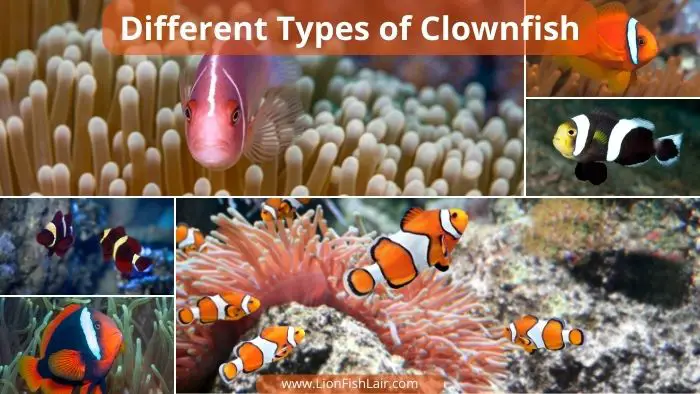
There are so many different species of Clownfish that vary in color, pattern, size, and general behavior, which means there is a Clownfish that suits every hobbyist and their preferences too.
It is important to understand when identifying Clownfish that there are 30 different types of Clownfish in total, which are split into groups commonly known as complexes. Each complex signifies the main characteristics of the Clownfish that fall into that group; weight, size, coloration, and patterns are all considered.
As we now know, there are so many different Clownfish, and this guide will help you identify and choose the right one for you and your reef fish community. Additionally, if you are starting out as a new hobbyist and Clownfish are your first aquarium inhabitants, then learning the right Clownfish tank setup is tremendously important information to know too.
How Many Types Of Clownfish Are There?
- Skunk Complex
- Tomato Complex
- Saddleback Complex
- Clarkii Complex
- Maroon Complex
- Percula Complex
With this list, you can pick the right Clownfish for you and your saltwater aquarium, not freshwater aquarium as clownfish are not compatible with freshwater. It comes as a surprise to many when they discover all the different types of Clownfish there are. They all have different behavioral patterns and aggressiveness, so make sure to pair your Clownfish with the best possible Clownfish tank mates you can.
Some of the names are more self-explanatory than others, but regardless, here is the list containing all 6 complexes and all 30 Clownfish species.
Skunk Clownfish (Maldive anemonefish) Complex
The somewhat unusual name given to this complex is not because these fish smell bad, it is because they both feature a long white stripe that runs down their back. Clownfish that belong to this subfamily are the Pink Skunk Clownfish and the Orange Skunk Clownfish. As you may have guessed, the Pink Skunk Clownfish sports a light pink appearance, and the Orange Clownfish an orange, more generic Clownfish appearance.
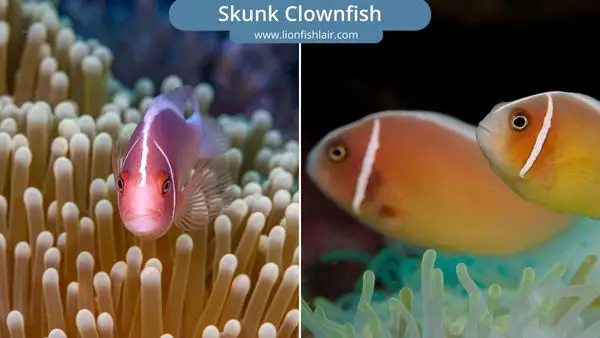
These Skunk Complex Clownfish are the second-largest type of Clownfish species, and they are incredibly rare compared to some of the other fish featured on this list and possess unique characteristics and behavioral patterns. They are peaceful fish and will brighten up any aquarium. They are also tremendously well-behaved and are a great option for hobbyists at any stage of their journey. When you begin your tank setup, it is strongly advised to choose equally peaceful fish to accompany them, avoiding larger predatory fish.
Tomato Clownfish (Amphiprion frenatus) Complex
The two Tomato Clownfish that are under this complex subfamily are not the most aesthetically pleasing Clownfish, but they are certainly the hardiest, oh, and by far the rarest clownfish species too. They will not likely contract deadly diseases and will live a pretty healthy and happy life if you look after them properly. Also, they are the third-largest type of Clownfish after the Clarkii and Skunk Clownfish complexes.
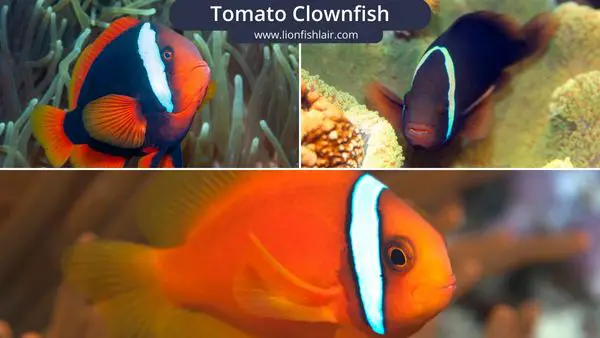
Sure, they might not be as beautiful as the other types of Clownfish (they say that beauty is in the eye of the beholder!), but they still look great and are incredibly durable fish and perfect for beginners. They are also great for breeding and are one of the most commonly found types of Clownfish amongst hobbyists. However, when it comes to breeding and pregnant clownfish, there is a lot to consider, so you must take the correct measures to be successful. Their pattern, although perceived by many as not being particularly attractive consists of one white band, located behind their eyes.
A common question regarding Clownfish is "what is the most peaceful Clownfish?", well, your answer is Tomato Clownfish, or, at least, they are unquestionably one of the most peaceful Clownfish types. They can live with literally any type of fish due to their relaxed and peaceful nature, they even tolerate being housed with much larger aggressive fish.
Saddleback (Amphiprion polymnus) Complex
What is the rarest Clownfish? Saddleback Clownfish are perhaps the rarest, most beautiful, but also most difficult to keep happy and healthy out of all the other Clownfish complexes. The three Clownfish species that fall under this complex are the Wind-Band Clownfish, the Saddleback Clownfish, and the Sebae Clownfish.
The name is derived from their appearance, sporting unusual stripes that resemble saddles all across the fish's back. Another unique and polarizing attribute these Clownfish possess is their dark, in some cases black coloration - when you think of Clownfish, you think of bright, almost neon orange colors, but these fish haven't read the script!
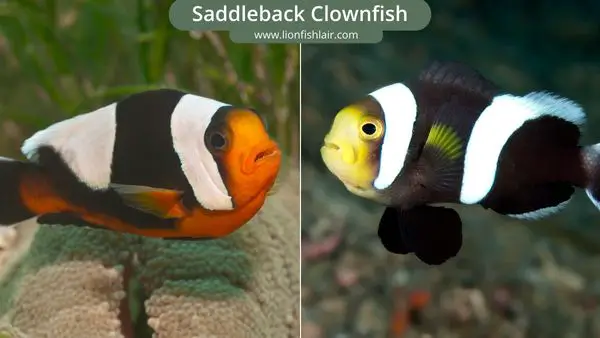
These fish are larger than most species of Clownfish and can be a bit of a handful, especially for beginners. If you are just starting out then perhaps choosing another from this list is a safer bet. They are also very expensive due to their exotic and rare nature and will require a bigger tank than the classic 30 gallon Clownfish tank, 40 gallons will do just fine.
Their behavior is rather erratic too, and you should fill your tank with as much stimulating décor as possible to prevent boredom and unhappiness. Also, make sure your tank has a hood or lid as these are jumpers!
All in all, the three Saddleback Clownfish species are hard work and require a lot of extra attention, but if you are experienced enough, and are willing to put in the work then the Saddlebacks will make for fantastic new additions.
Clarkii Clownfish (Amphiprion clarkii) Complex
The Clarkii Complex is unquestionably the largest of the 6 subfamilies of Clownfish. In total, there are 11 species that fall under this group of fish, and Clarkii's are the most commonly found and also one of the largest Clownfish in the fishkeeping hobby. Here are the 11 different species of Clarkii Clownfish:
- Clark's Anemonefish
- Yellowtail Clownfish
- Clark's Clownfish
- Clark's Clown
- Black Clown
- Brown Anemonefish
- Chocolate Clownfish
- Two Banded Anemonefish
- Sebae Anemone fish
- Sea bee
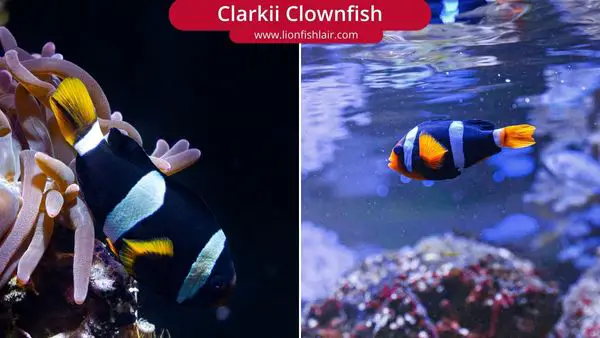
Most of the Clownfish that feature in this Complex are similar, but each do possess unique characteristics. They are also the easiest and most hassle-free to care for and look after, making them a brilliant option for beginners.
They are extremely hardy and feature the incredibly stunning patterns we are used to seeing in Clownfish. They tend to grow to a maximum of 5.1 inches (13cm). When it comes to tank mates, choose carefully as they tend to not play so well with similar species.
Maroon Clownfish (Amphiprion biaculeatus) Complex
Maroon Clownfish are incredibly popular members of the rather large Clownfish family, recognized easily due to their maroon complexion and unique, three-strip pattern, with the Sumatra Clownfish sporting golden stripes in some instances. They are also distinctively large fish, growing up to 6.3 inches (16cm).
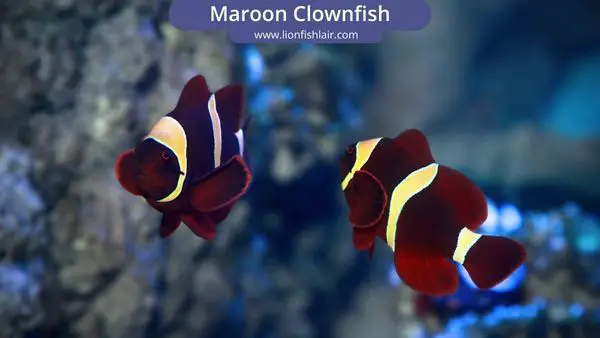
Like the majority of their Clownfish counterparts, the Maroon Clownfish are tremendously hardy, which is perfect for beginners or those without an abundance of time at their disposal. The only thing you need to watch out for is their aggressive tendencies. They can become very territorial and sometimes even bully other species of Clownfish.
Percula Clownfish (Amphiprion percula) Complex
The most popular, commonly-known, and best type of clownfish for beginners has to be the Percula Clownfish species. These common Clownfish are symbolic with hobbyists for a plethora of different reasons stemming from their significance in the rising popularity of fishkeeping.
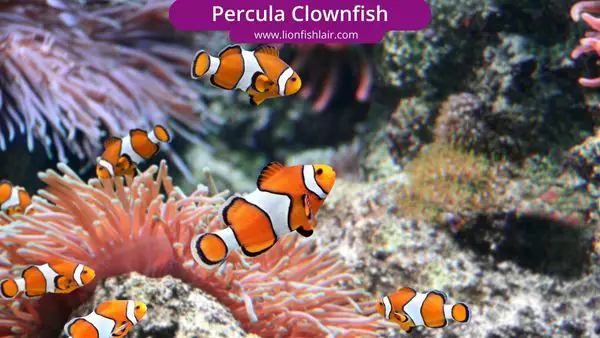
There are 4 different species that all fall under this subfamily, with the majority taking up the simple appearance of bright orange with thick white stripes draped across their bodies. They are known to be the first-ever captive-bred Clownfish and come in different varieties, and with them being bred for commercial purposes, there are dozens of great options for you. These clownfish in particular are schooling fish, but can they live alone?
What Is The Best Type Of Clownfish?
This question is posed a lot, and truthfully, there is no right answer. Each hobbyist has their own preferences, experience level, and aquarium size, meaning that it is totally subjective and up to the fishkeeper to make up their mind from this list which is the best suited to them. However, the most popular type of Clownfish are without a doubt Percula Clownfish, not only are they more common than the other types, but they are easier to look after and peaceful by nature.

